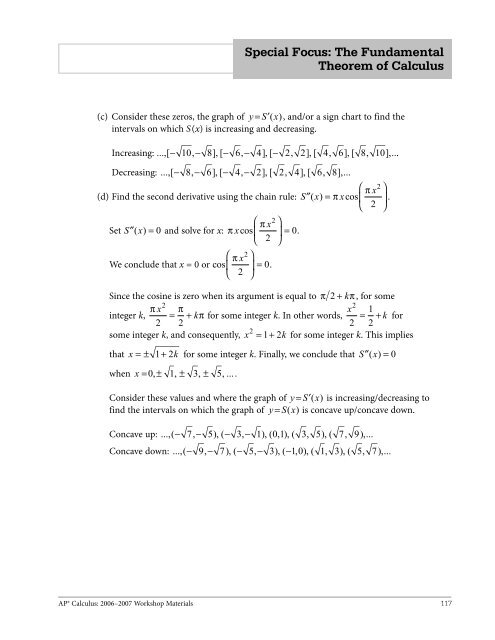AP Calculus
You also want an ePaper? Increase the reach of your titles
YUMPU automatically turns print PDFs into web optimized ePapers that Google loves.
Special Focus: The Fundamental<br />
Theorem of <strong>Calculus</strong><br />
(c) Consider these zeros, the graph of y = S′( x), and/or a sign chart to find the<br />
intervals on which S(x) is increasing and decreasing.<br />
Increasing: ...,[ − 10, − 8], [ − 6, − 4], [ − 2, 2], [ 4, 6], [ 8, 10 ],...<br />
Decreasing: ...,[ − 8, − 6], [ − 4, − 2], [ 2, 4], [ 6, 8 ],...<br />
⎛<br />
(d) Find the second derivative using the chain rule: S′′ ( x) = π xcos⎜<br />
⎝<br />
⎛ π x<br />
Set S′′ ( x) = 0 and solve for x: π xcos⎜<br />
⎝ 2<br />
⎛<br />
We conclude that x = 0 or cos π x2 ⎞<br />
⎜ ⎟ = 0.<br />
⎝ 2 ⎠<br />
2<br />
⎞<br />
⎟ = 0.<br />
⎠<br />
π x<br />
2<br />
2<br />
Since the cosine is zero when its argument is equal to π 2 + k π , for some<br />
integer k, π 2<br />
x π kπ<br />
2 = 2<br />
+ for some integer k. In other words, x 2<br />
1<br />
= +<br />
2 2<br />
k for<br />
2<br />
some integer k, and consequently, x = 1+ 2k<br />
for some integer k. This implies<br />
that x = ± 1+<br />
2 k for some integer k. Finally, we conclude that S′′ ( x) = 0<br />
when x = 0, ± 1, ± 3, ± 5, ....<br />
Consider these values and where the graph of y = S′( x) is increasing/decreasing to<br />
find the intervals on which the graph of y = S( x) is concave up/concave down.<br />
Concave up: ...,( − 7, − 5), ( − 3, − 1), ( 0, 1), ( 3, 5), ( 7, 9 ),...<br />
Concave down: ...,( − 9, − 7), ( − 5, − 3), ( −1, 0), ( 1, 3), ( 5, 7 ),...<br />
⎞<br />
⎟ .<br />
⎠<br />
<strong>AP</strong>® <strong>Calculus</strong>: 2006–2007 Workshop Materials 117


